Behind the PERMIND guide there are two stories: the story of an anecdote that turned into a symptom and the story of a life project that leads to the Association for the Development of Permaculture (ADP), entity responsible for the development of this permaculture guide.
Let’s start with the anecdote. The 10th of November 2016 the ADP received an express e-mail with the subject “Proposal of collaboration with Foundation INTRAS”. The e-mail was signed by Laura Martínez Domínguez, from the Projects Department of the Foundation INTRAS, and it said:
Good morning:
I am Laura Martínez, projects manager of Foundation INTRAS. I left a message on your voicemail but I thought it would be interesting if you had the information in writing as well so you knew the reason for my call.
We are a non-profit body with the aim to improve the life quality of people suffering from severe and long-term mental illness. We have been working since 1994 and we have centers in several provinces of Castile and Leon (Toro, Zamora, Valladolid, Peñafiel, Benavente and a supervised flats network and community social support teams in other provinces of the region). We count on a projects department, which I am part of, which mission it is to search funding for our activities (we are a private foundation) and facilitate overall new activities for our users (targeting their recovery and full integration). We search this funding mostly in Europe through our involvement in many European projects. That is exactly why we contact you.
We are preparing a project proposal for an Erasmus+ call based on permaculture in order to write a training guide in order to train persons with mental health issues in this field. We have seen that your Association for the Development of Permaculture applies permaculture as therapy and we are interested in your experience and we want to suggest a partnership in this European project along with us. We have recently been able to launch an ecological horticulture line made possible due to another European project too: the HORGANIC project. We would like to go even further and get to know the permaculture world and see if it could represent an added value for our work with persons with mental illnesses. We also work along with the agricultural engineering school INEA and its urban vegetable gardens project. I hope you find our proposal interesting and I look forward to your response.
With kind regards,
Laura Martínez Domínguez – Projects Department of Foundation INTRAS
Five months later on March 27th2017, the PERMIND project proposal was presented in the Key Action 2 Framework – Strategic Partnership for Adult Education (KA2014) of the Erasmus+ program, with the type Innovation Development. A project composed of five partners: the mentioned Foundation INTRAS as main partner, the Slovenian SENT (Slovenian Association for Mental Health), the Greek Society of Social Psychiatry & Mental Health, the Swedish Changemaker and the Association for the Development of Permaculture.
Four months later on July25th, the project was approved. The kick-off meeting took place on the 25th and 26th of October the same year in the ADP headquarter, Finca El Mato Tinto, Tacoronte, Tenerife. A day prior to the meeting, we asked Laura Martínez something that had been left out: How did INTRAS find out about ADP? Laura, agricultural engineer graduate, told us she heard about permaculture at some point during her university training. After having worked on her ecological horticulture project as a therapeutic tool for INTRAS, she wanted to learn more about the mental health recovery potential of permaculture. When she was searching information, she googled “mental health permaculture” and immediately found results about the ADP. From that point on, she got into contact with the association.
That’s the anecdote story. An anecdote that ends up becoming a symptom, a signal of something already happening: the act of permaculture being applied to mental health recovery, a process we will share in this training guide starting from the ADP experience.
We move on to the second story: a story of a life project that leaded to the foundation of the ADP. A story that intends to serve as a visiting card of the ADP training experience and as a transfer of knowledge represented by the PERMIND guide. The story is presented with some hints of this training activity.
Since 2002 the ADP has remained active in a big training activity in the Finca El Mato Tinto working in different fields: the first experience was all about mental health therapy and pre-labour and labour integration training of the Special Employment Center Finca El Mato Permacultura (CEE). This will be addressed in the Didactic Unit 1 of this guide for its relevance for persons with mental health illness.
Since then until now –March 2018– many training activities have been carried out in elementary school, high school, professional and university training, extended training activities of public administration, and farmer-to-farmer and farmer-expert projects where permaculture is shown as an observation activity of the natural ecosystems dynamics. This observation helps to design production systems that meet human needs without any environmental degradation.
When it comes to systematize and develop the PERMIND guide, we have relied on four training activities developed in the Finca El Mato Tinto during the last 16 years.
– The mentioned Special Employment Center Finca El Mato Permacultura (2002-2013), a social company focused in pre-labour and labour integration through permaculture-based mental health therapy (Figure Int.1).
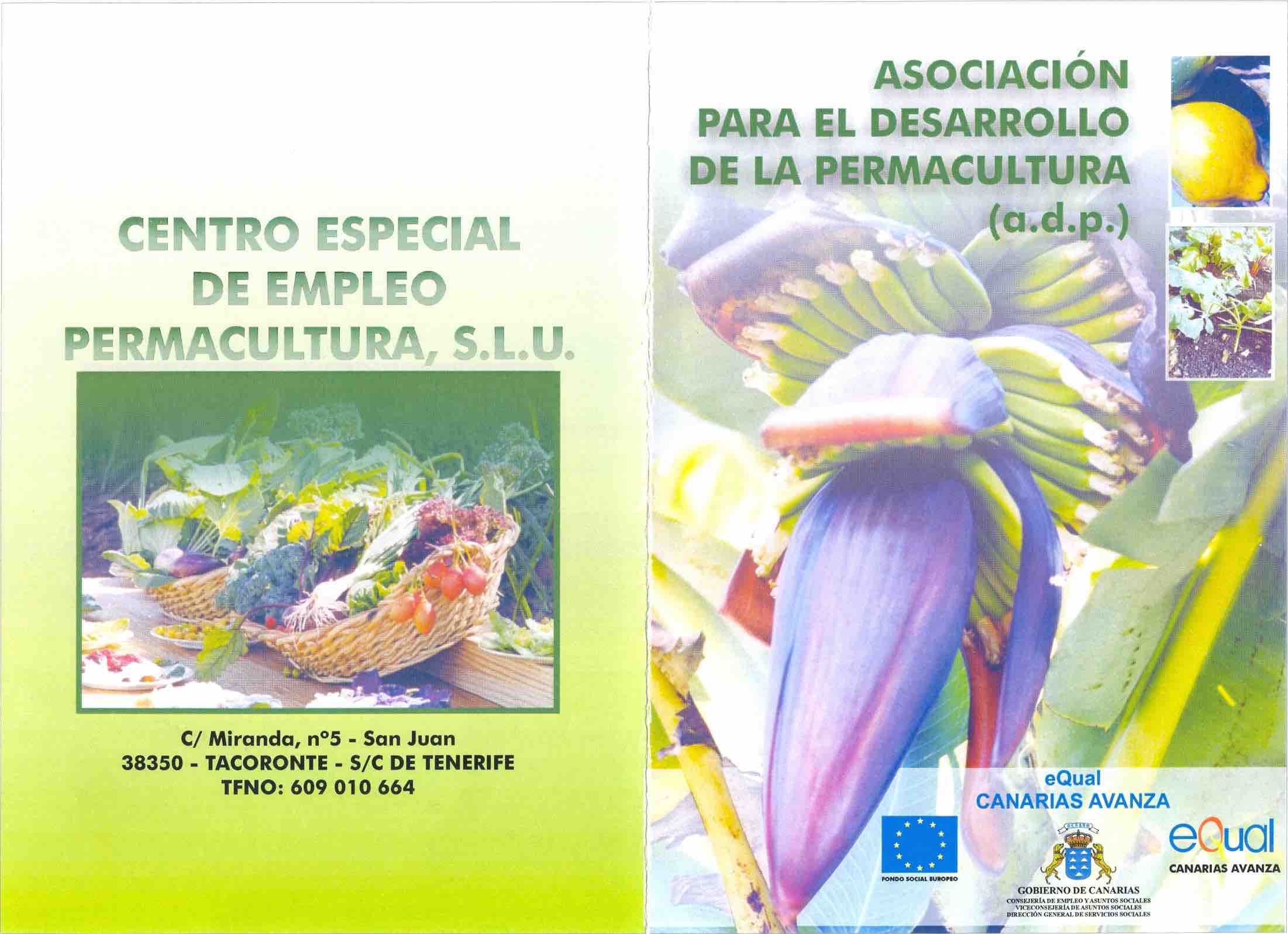
Figure Int.1 – Informative CEE and ADP poster
-The “That’s how we do it in the garden” project (2011 until now, 2018). A project made along with the Tacoronte City Hall Education Council, where the ADP and its headquarter, the Finca El Mato Tinto (FEMT), are located, and in which the University of La Laguna has collaborated as well. The academic management of the project has been carried out by Juan Castro de Paz, ADP collaborator and university professor. The project intends to enhance the school vegetable gardens of every Educational Center of the council through 3 main activities: 1) A training course in the farm for the teachers responsible of the school vegetable garden; 2) A students group visit with the teachers from each educational center to the FEMT, where they follow scheduled activities related to permaculture (visit to the farm, seeding and planting activities, invertebrates and microorganisms observation with a bifocal lens, the natural purification system of wastewater, interaction with farm animals, etc.) (Figure Int.2); and 3) A monitoring and advice in situ of the ADP staff in the school vegetable gardens.
The monitoring and advice purpose is to check the development level of the permaculture techniques applied in the vegetable gardens, to advice about their implementation, to solve the doubts of the teachers responsible of the school vegetable gardens, and to meet the demands needed for the project improvement. The 2017-2018 academic course is its 7th edition.
Table of contents
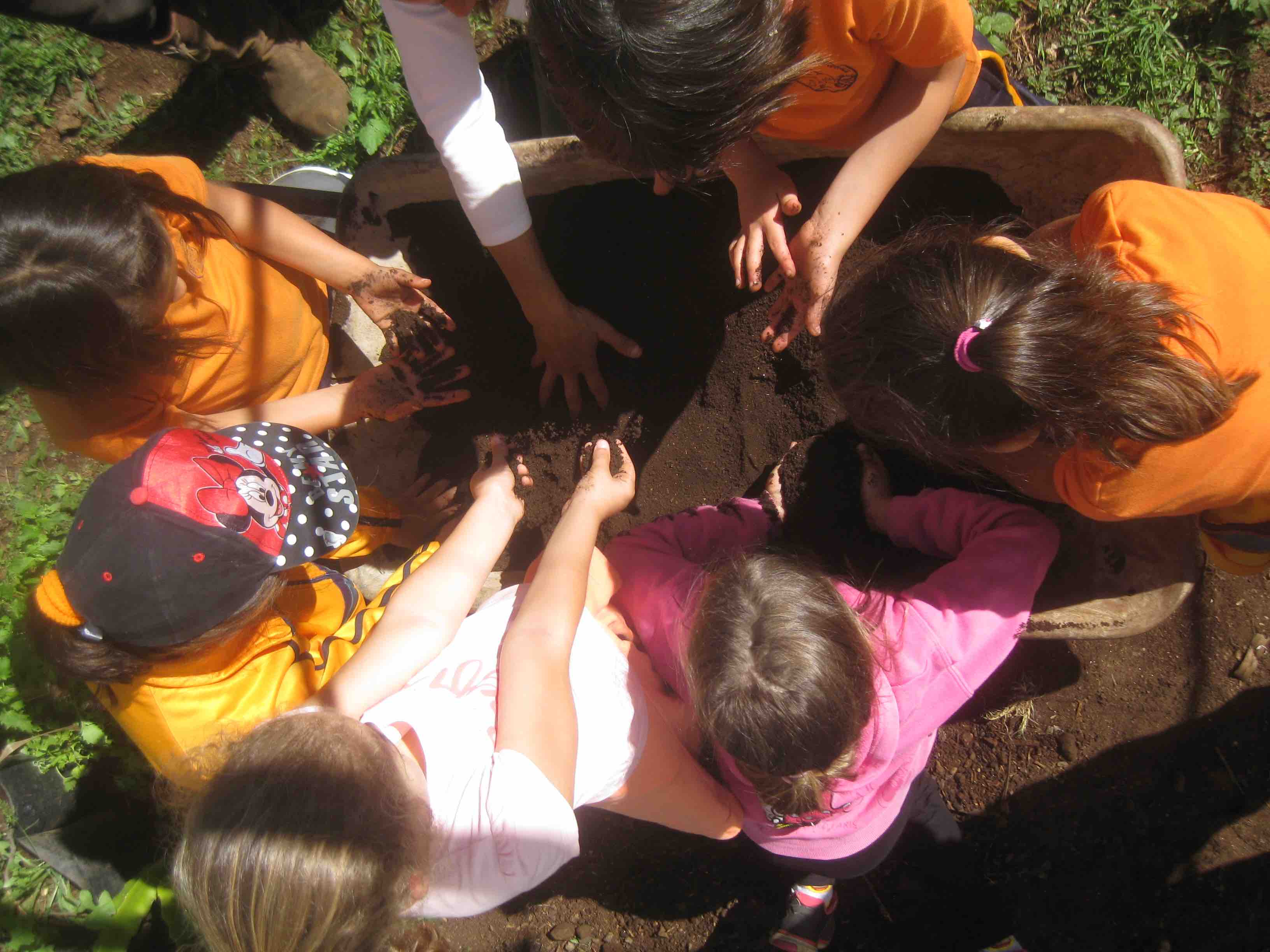

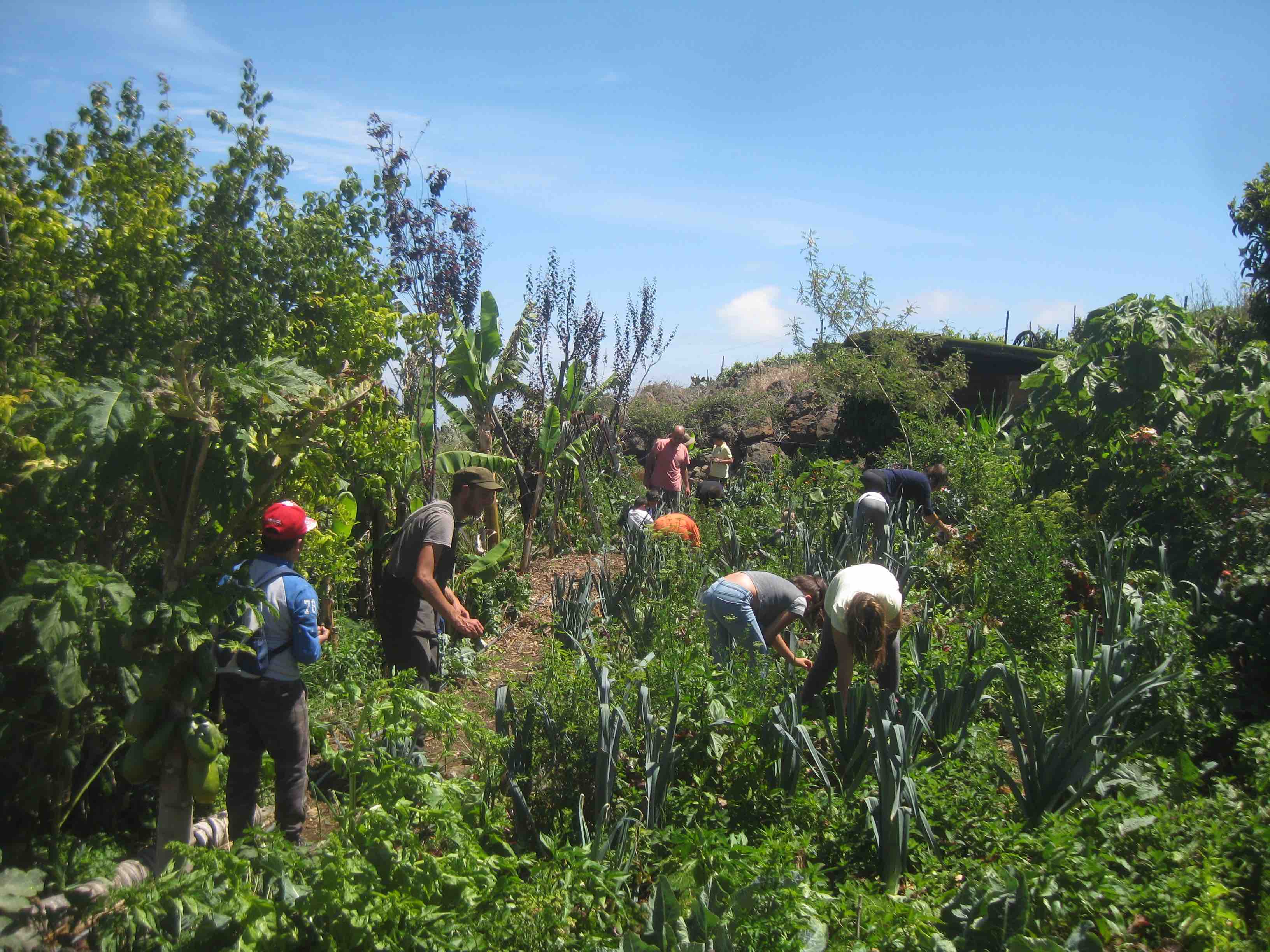
Figure Int.2 – Images of various activities of the “That’s how we do it in the garden” project
This experience of permacultural knowledge transfer and replicability has been very useful for ADP as a partner in order to meet the PERMIND objectives. It is also an opportunity to spread the PERMIND project since the students and teachers are informed about it during the visits to the farm (Figure Int.3). It is a strategic social group that can make PERMIND visible in their families.
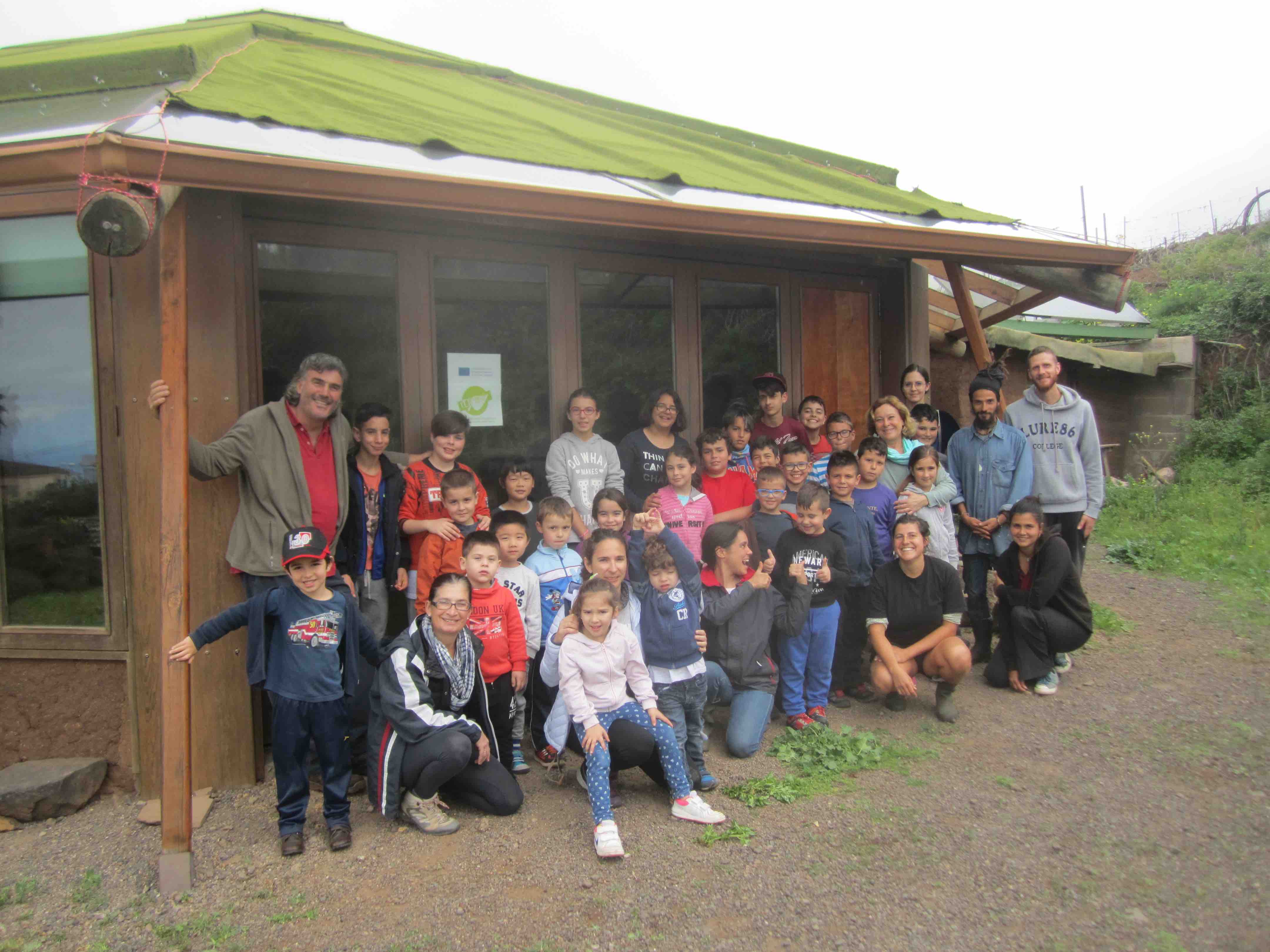
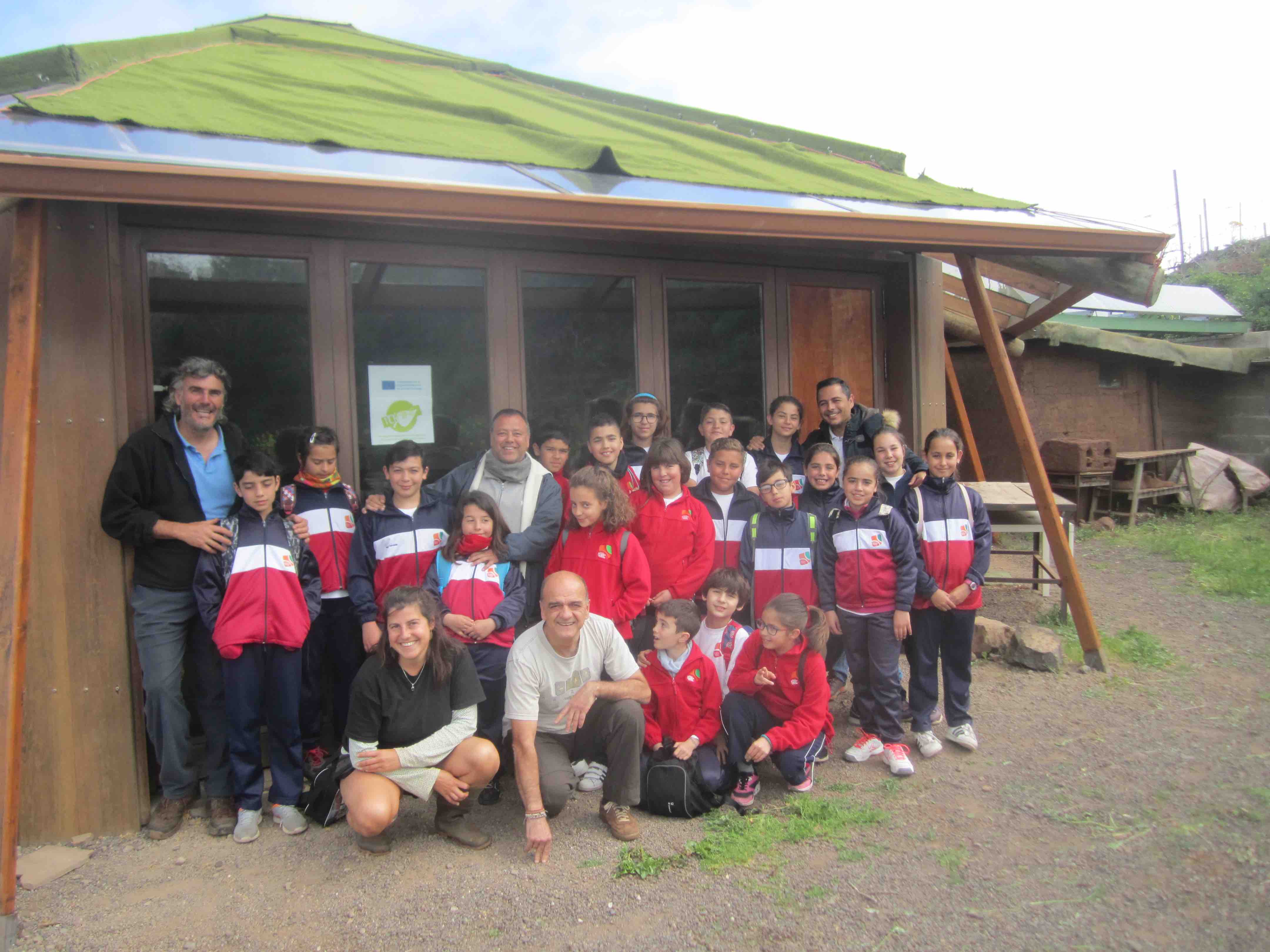
Figure Int.3 – Images of pupils and teachers from the CEIP San Juan Perales (to the left) and Ernesto Castro Fariña (to the right) with ADP collaborators after explaining the PERMIND objectives in the “That’s how we do it in the garden” project activities framework (March 2018)
– Five interdisciplinary and transdisciplinary courses of the University of La Laguna (2012-2016), competitive university courses that used the FEMT as a learning classroom (Figure Int.4). The management of these courses has been carried out by Juan Sánchez García, ADP collaborator and university professor (Figure Int.5). The public targeted by the courses can be anyone, academic or not, who is interested in the subject.
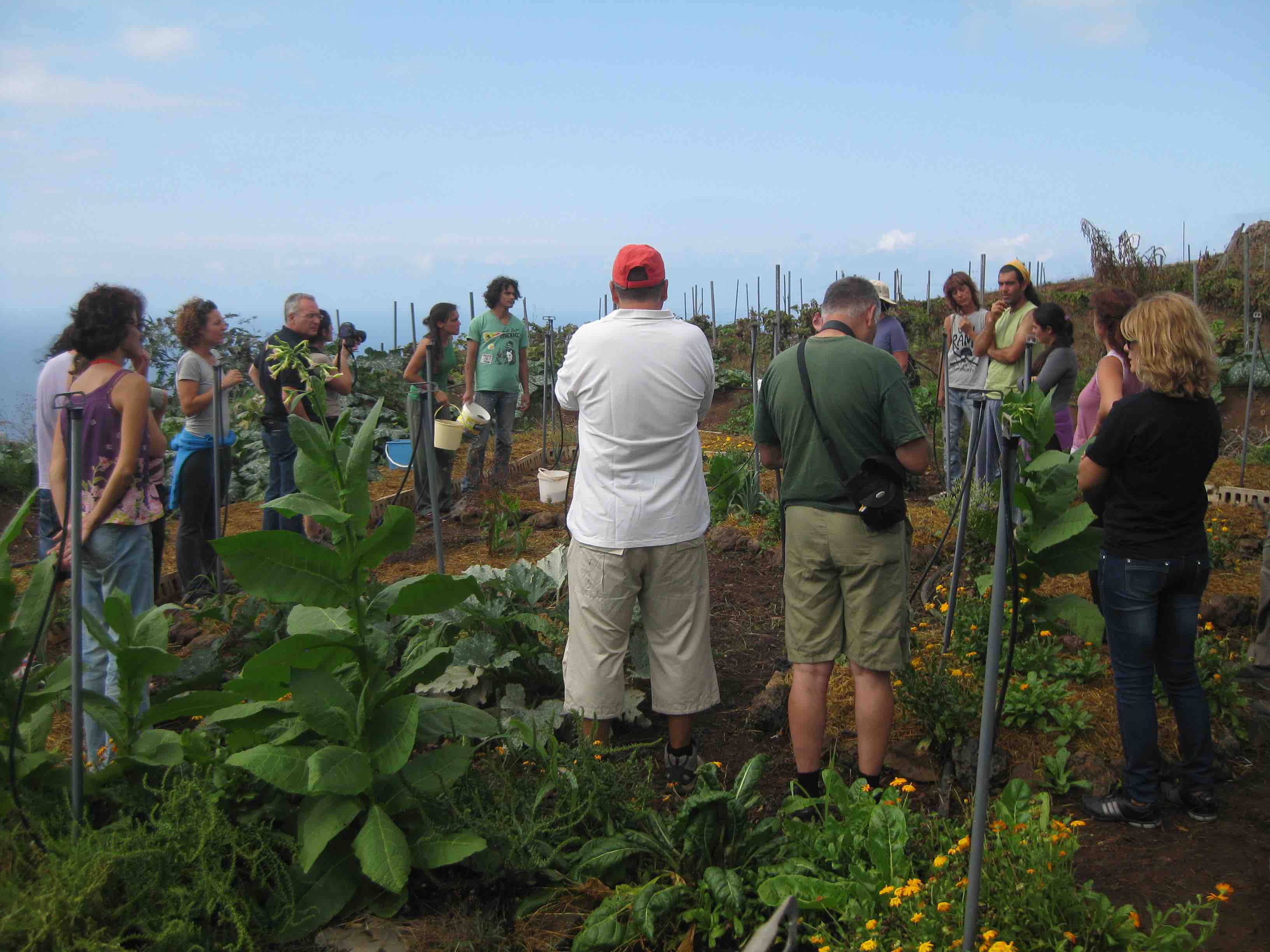
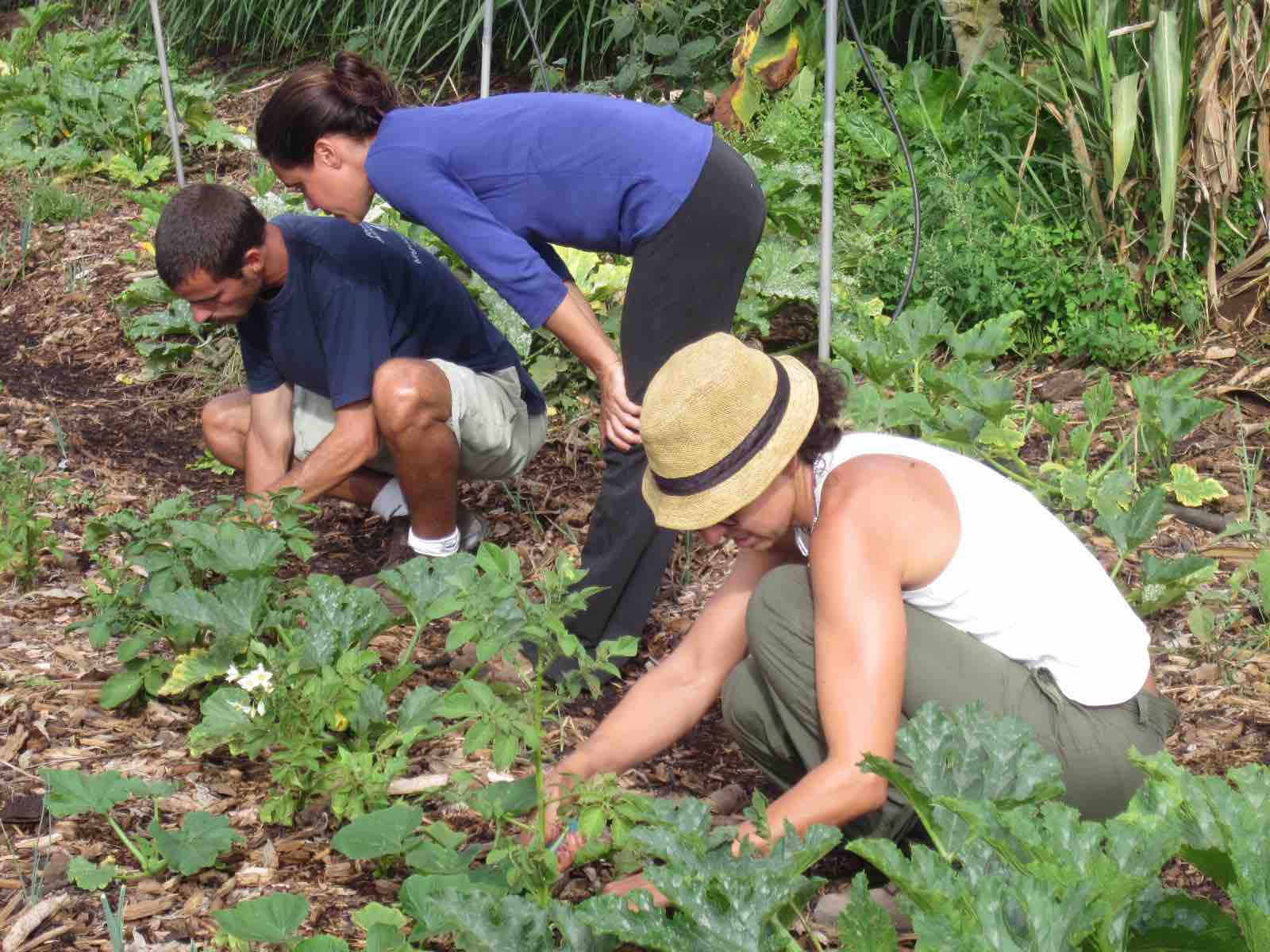
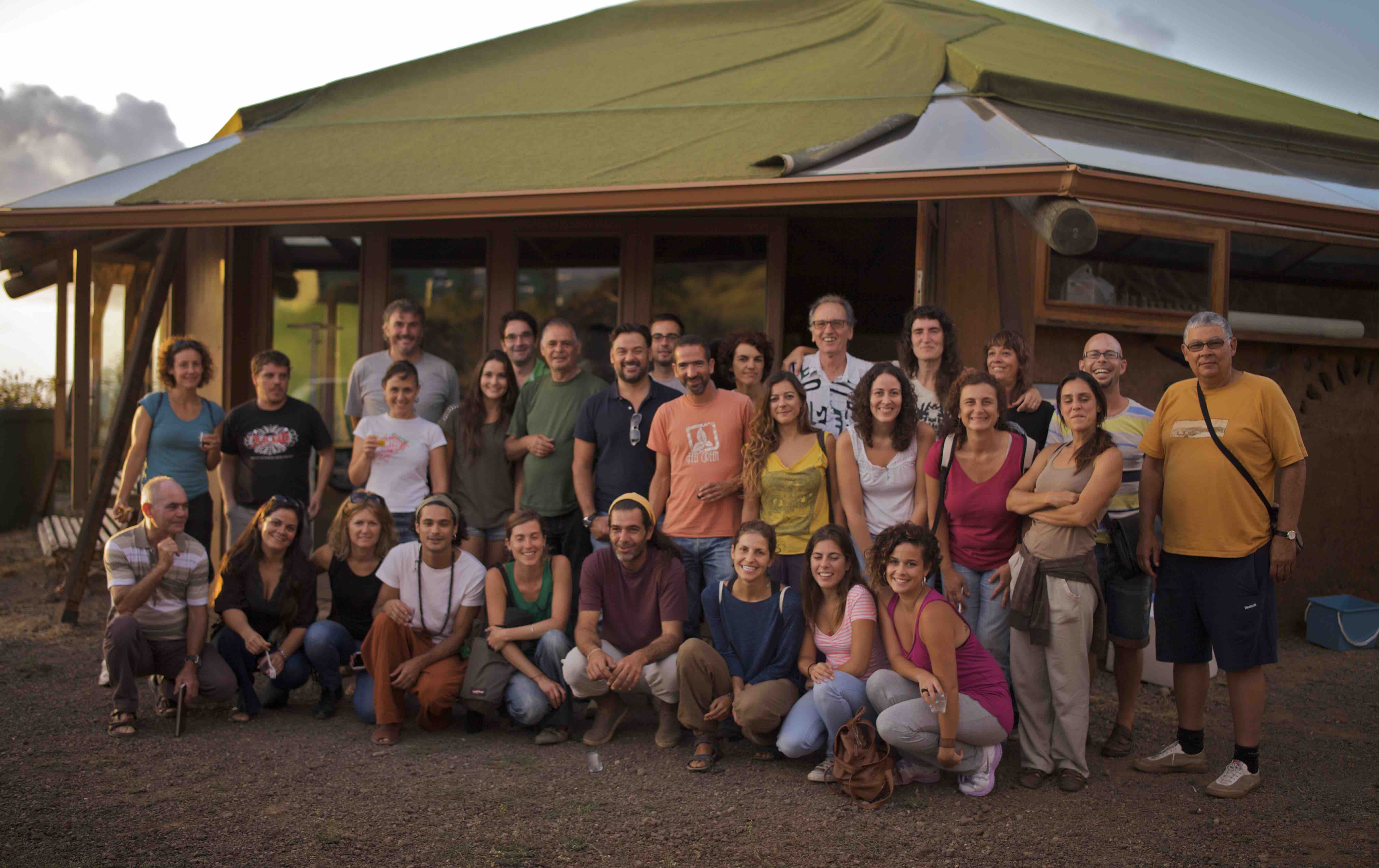
Figure Int.5 – Images of a poster and various activities of interdisciplinary and transdisciplinary courses of the University of La Laguna in the FEMT.
As an indication, the titles of the 5 courses:
- First observe and then reflect in the wake of perception: creation of proximity in the university-society relationship (CIULL2012).
- The setting of limits: a new cultural awareness (CIULL2013).
- Transition initiatives and research oriented to and with the community (CIULL2014).
- Cultivating soil, food and health (CIULL2015)
- Permaculture as an opportunity for transdisciplinary dialogue (CTULL2016).
These training activities had a high acceptance rate as the positive anonymous students survey shows about each course. These courses were composed of a great variety of students from various professional and social frameworks and ages.
An indicator of this training activity acceptance, and therefore as a training potential of the ADP and its FEMT, is shown by the answers given by the students on the last course edition to the question How would you evaluate the role of the Finca El Mato Tinto as the courses implementation place?
- Important and essential supporter of a true training with authentic trainers.
- It is a key place for inspiration, such a luxury that we have here in the island. An ideal campus for transdisciplinarity.
- It is the perfect space to learn. Everyone has to visit it and do some course here, no matter what you are dedicated to. “Everything is linked and integrated”
– LASOS project (2014-2016 stage). “CEE Finca El Mato Permacultura” project is declared good practice by the United Nations Human Settlements Programme (UN – HABITAT) in the 2012 edition (Figure Int.6). It is a program that promotes villages and cities to become socially and environmentally sustainable.
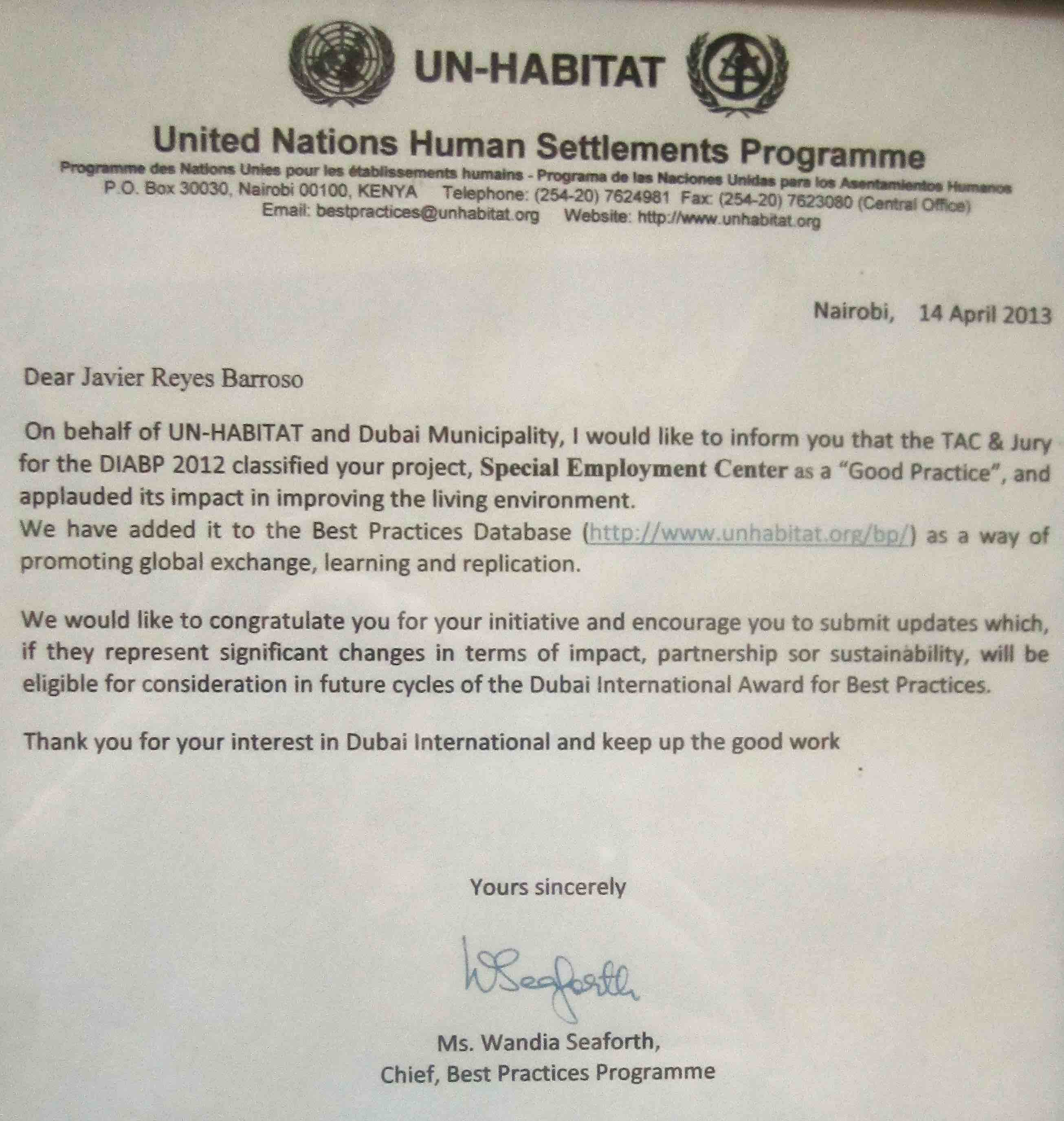
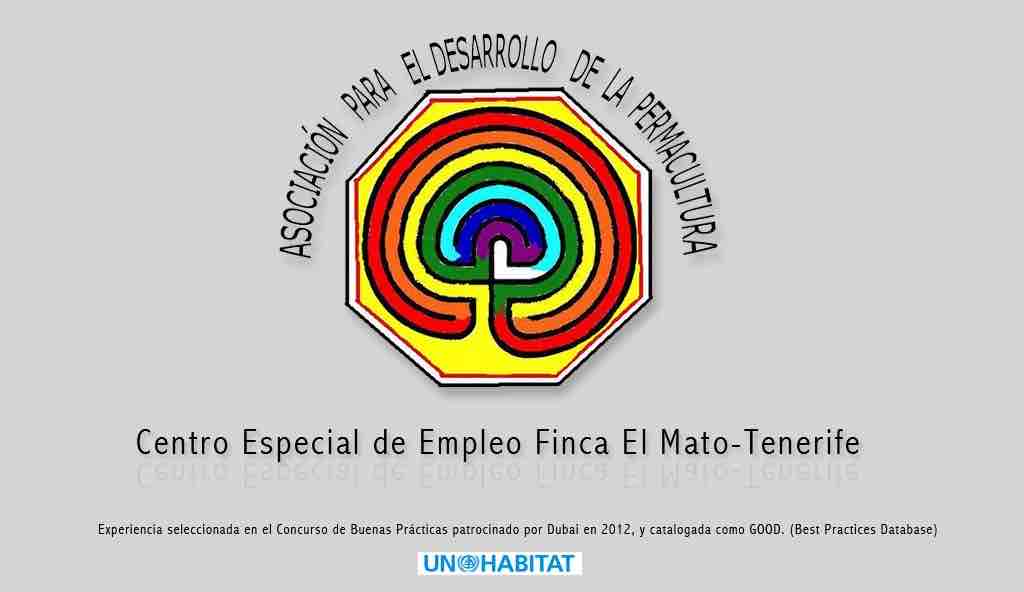
Figure Int.6 – Images of the CEE designation as a good practice by HABITAT
As a result of such qualification, island public administrations identified the ADP and its farm as a referral laboratory and center of the LASOS project (Agroecological Laboratory for Sustainability). This is an innovative project that was developed during a workshop in the Finca El Mato Tinto by farmers, researchers and technicians from various areas of the Tenerife Island Town Halls and other public and private entities with the aim to promote, to enhance and to develop agroecology and collaboration networks.
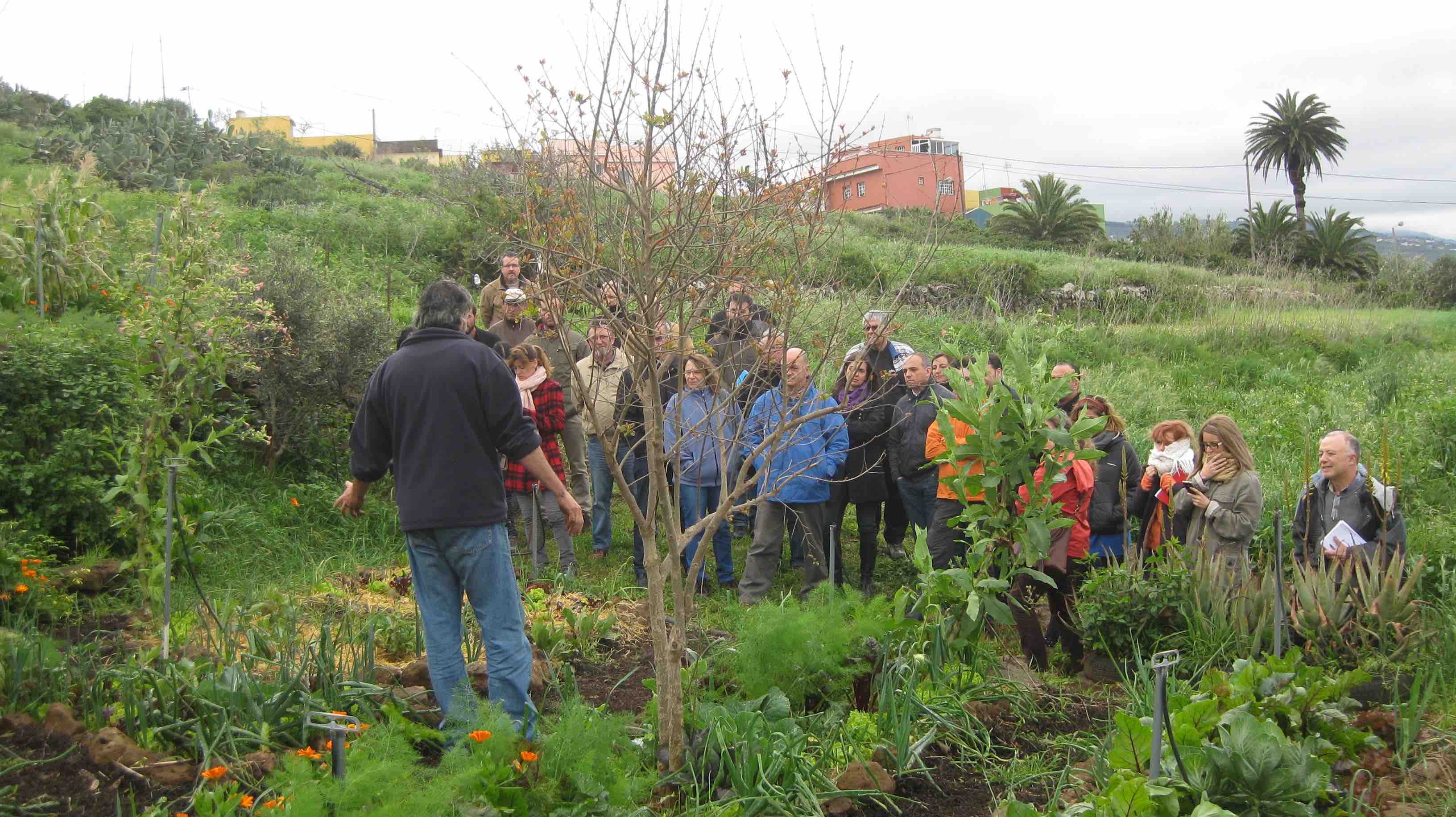
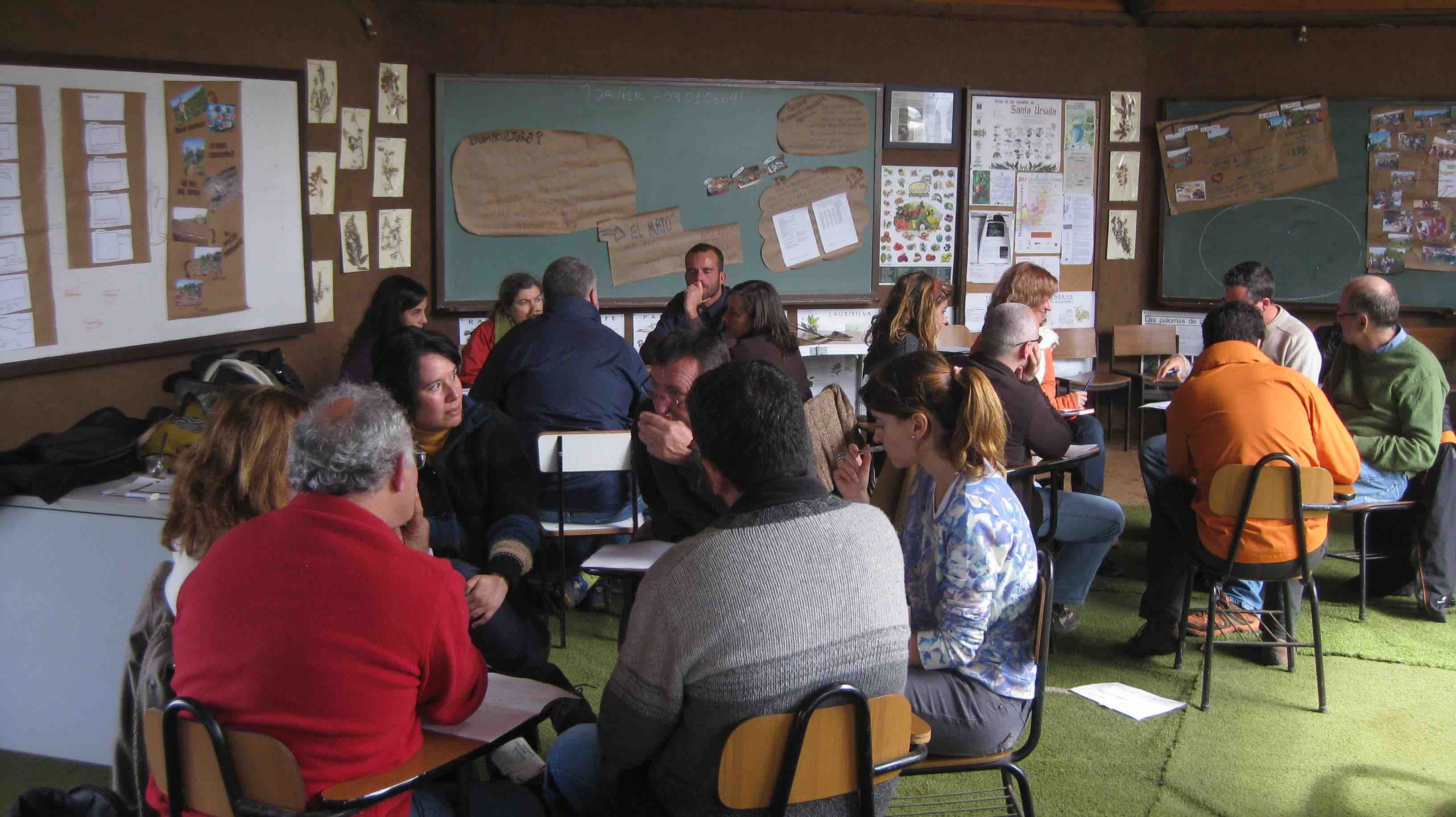
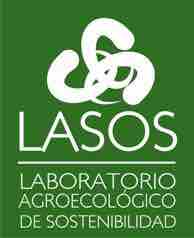
Figure Int.7 – Images of the LASOS project logo and the “ground connection” and co-creation of the project
The Finca El Mato Tinto, headquarter of the ADP, was taken as the referral experience, as the pilot case and inspiration source for the development of the project due to its aims of designing and recovering sustainable agroecological and social activities. An ADP declared of public interest.
The project has been a place where experiences and information are exchanged through the knowhow and the resources of the ADP: training in situ activities, agricultural advisory services, research, dissemination… in order to learn in a shared and cross-sectional way about real cases and to set the action guidelines with the largest range.
The visualization workshops arisen from the “ground connection” with permaculture were described as the core element in the addressed activities structure of the project (Figure Int.8).
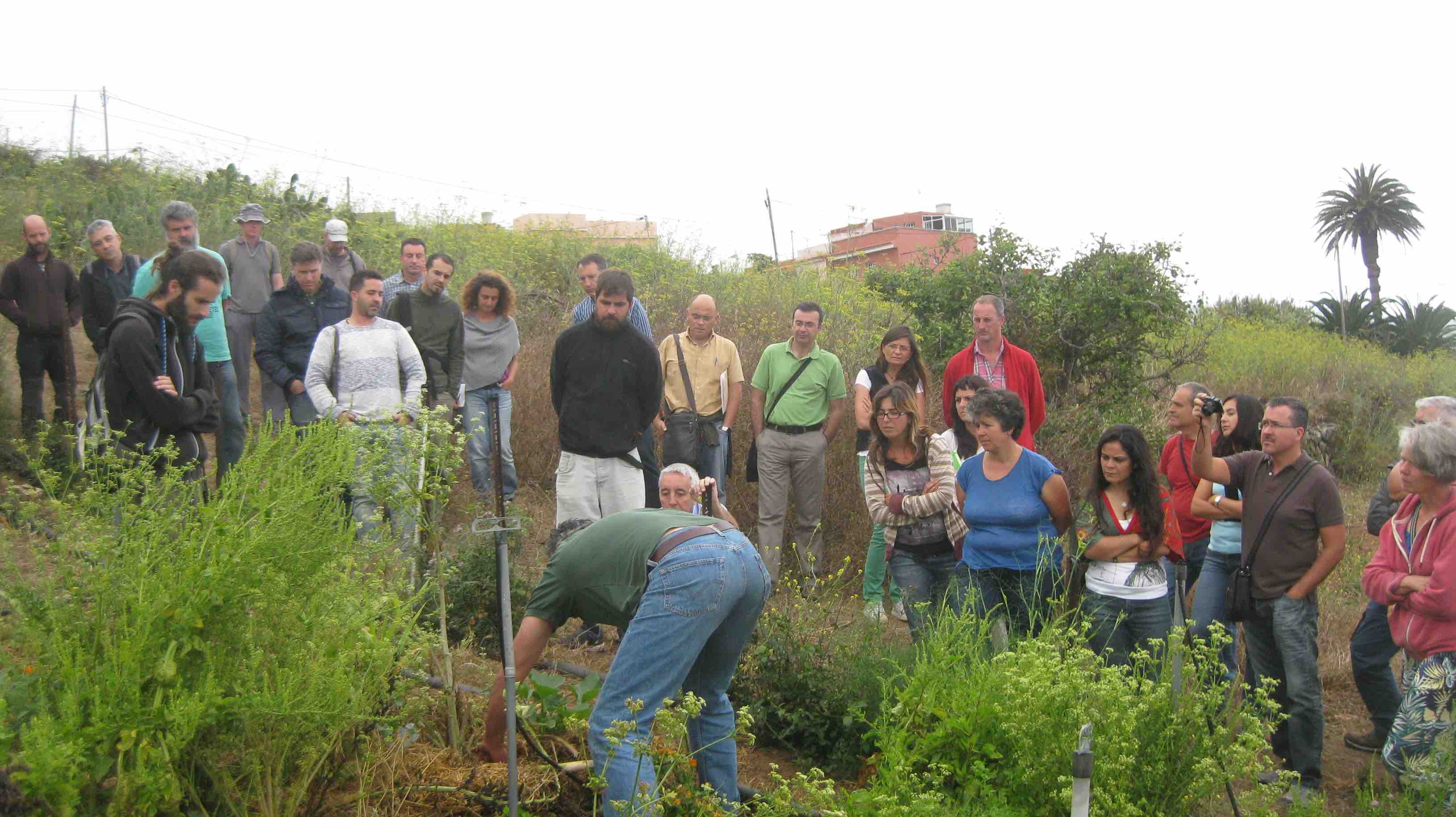
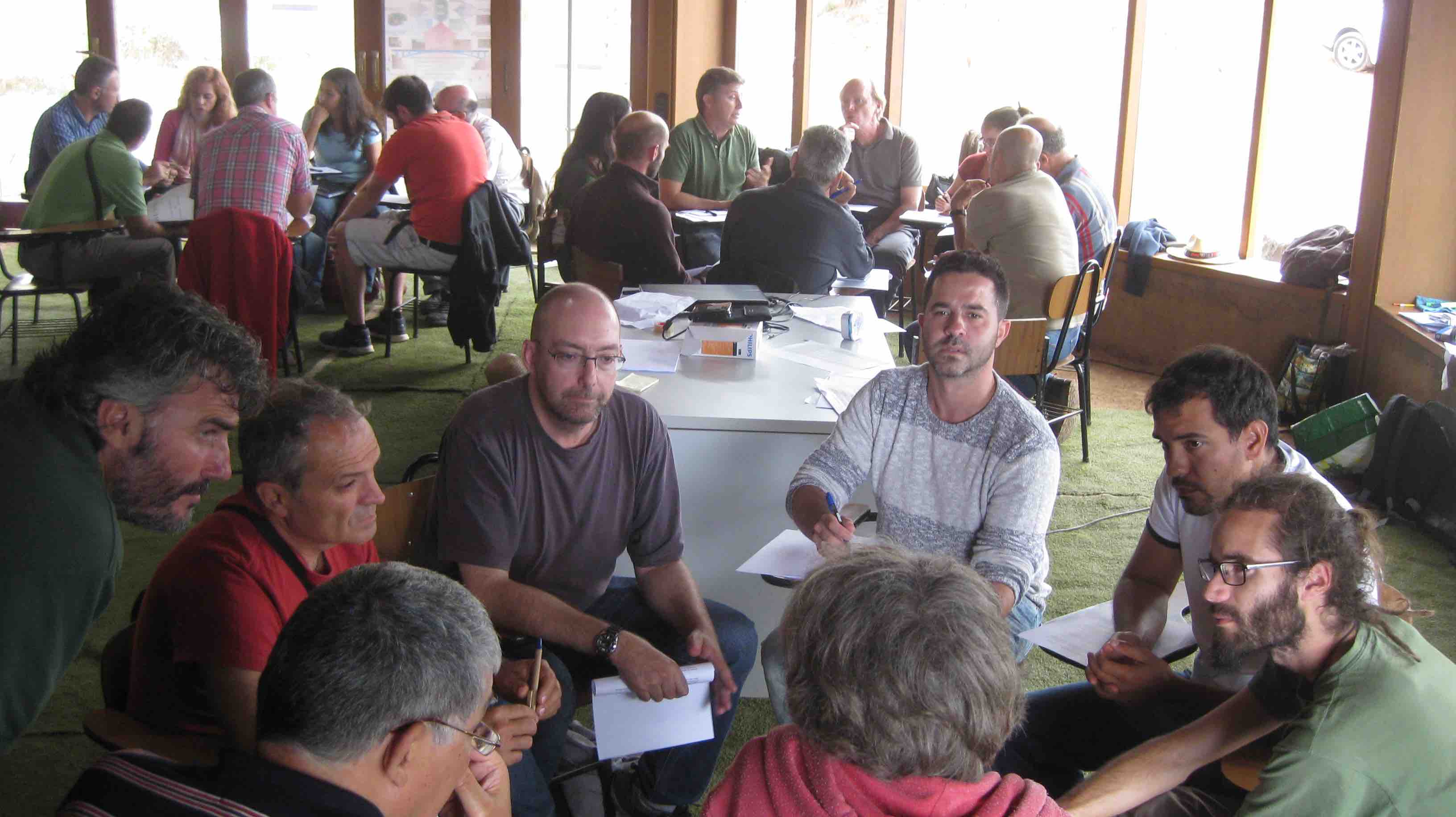
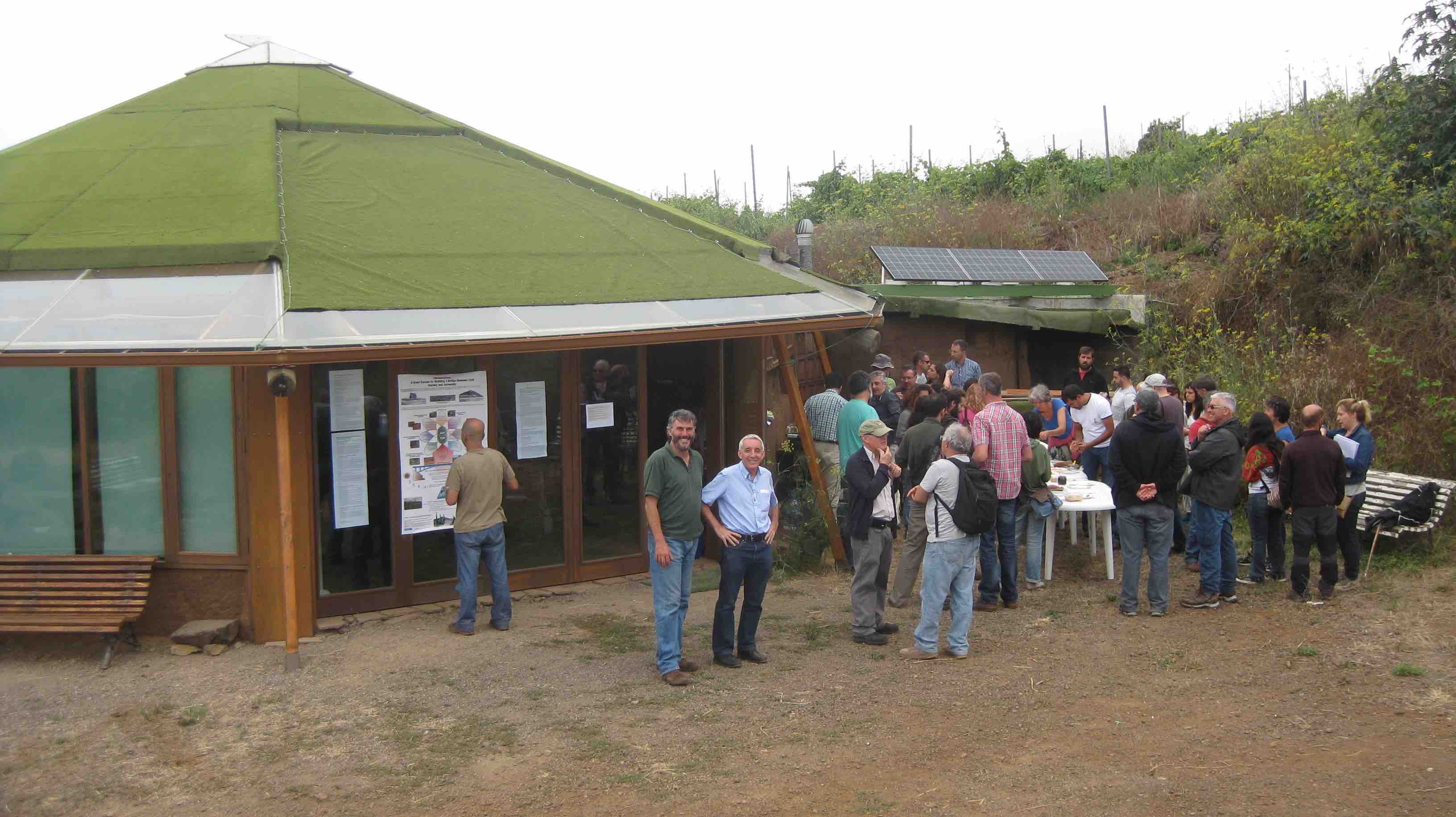
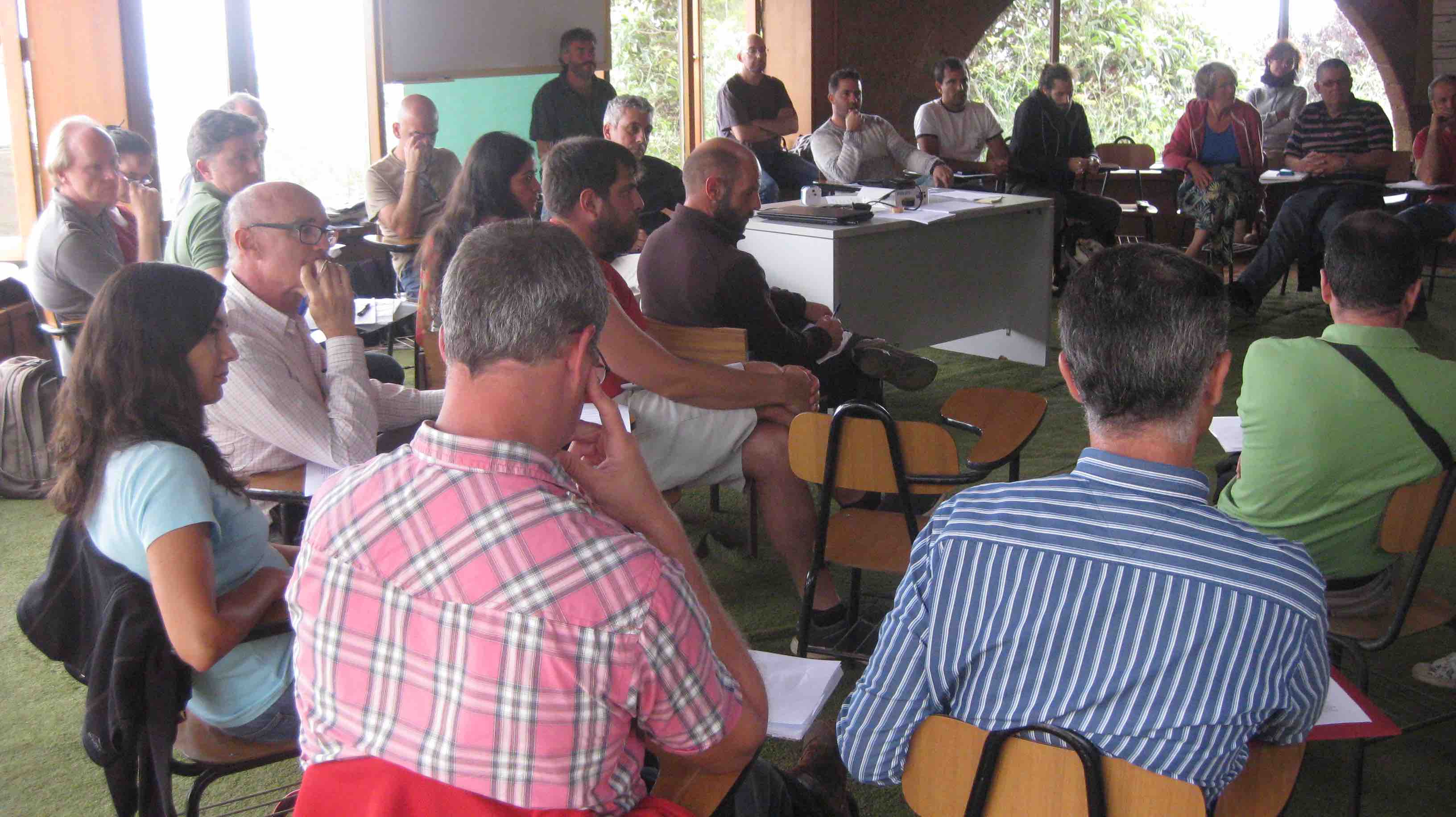
Figure Int.8 – Images of one of the LASOS project visualization workshops
These workshops were held through what we call the “ground connection” methodology, which we will talk about in the chapter “Methodology of the PERMIND guide”.
PERMIND GUIDE METHODOLOGY
To address the development and implementation of the PERMIND guide, there are two key ideas: the “ground connection” method and the “co-creation” approach.
The “ground connection” method forms in many ways a test in many ADP training activities that take place in the farm that ease communication, connection, motivation and involvement in an inspiring environment such as the FEMT. It aims to promote collaboration between persons and entities through the identification of mutual objectives and synergies.
Every person taking part in these training activities and workshops with this method start by feeling the place during a visit to the farm carried out by those responsible of the ADP.
This technique was implemented since the very first training activity in the farm with the construction of the Special Employment Center since the main therapeutic and training method have been applied since the very beginning of the setting up of the farm itself (Figures Met.1 & Met.2).
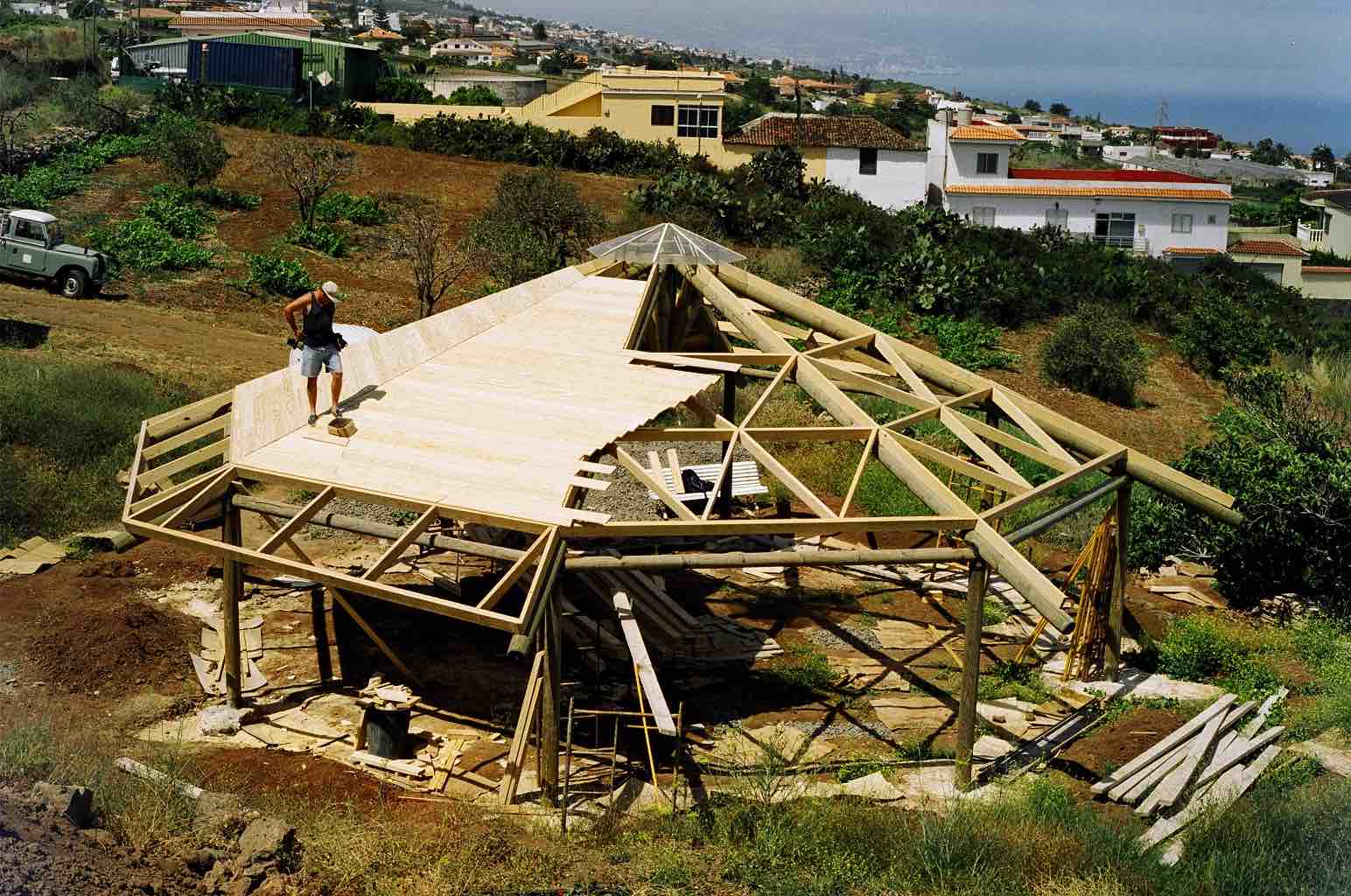
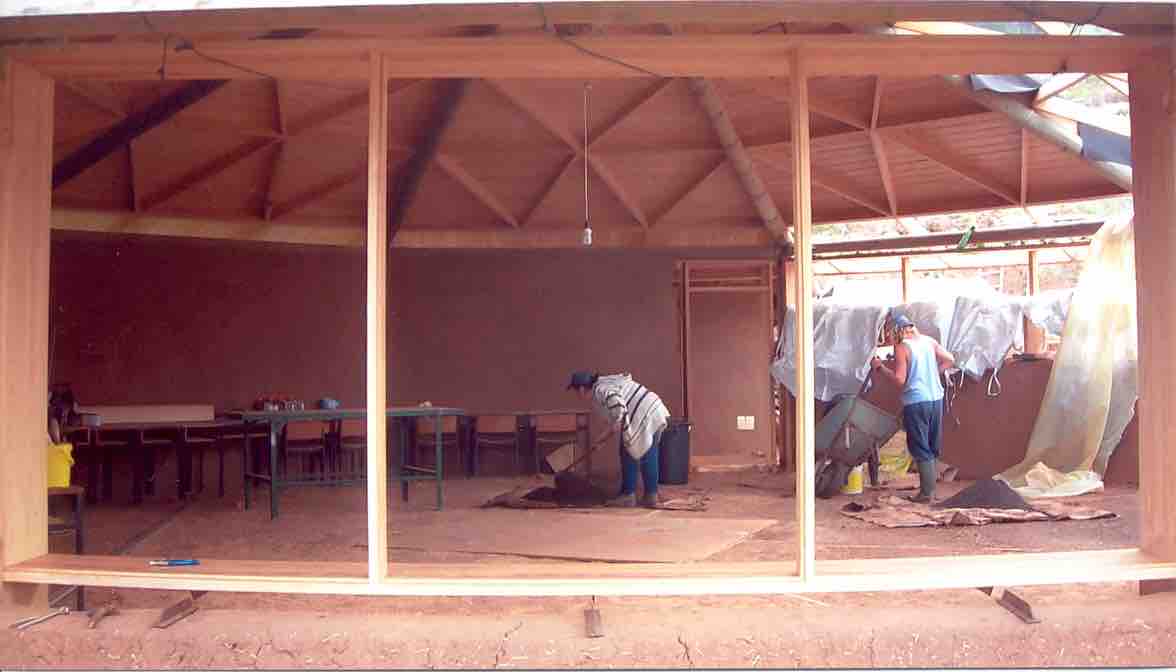
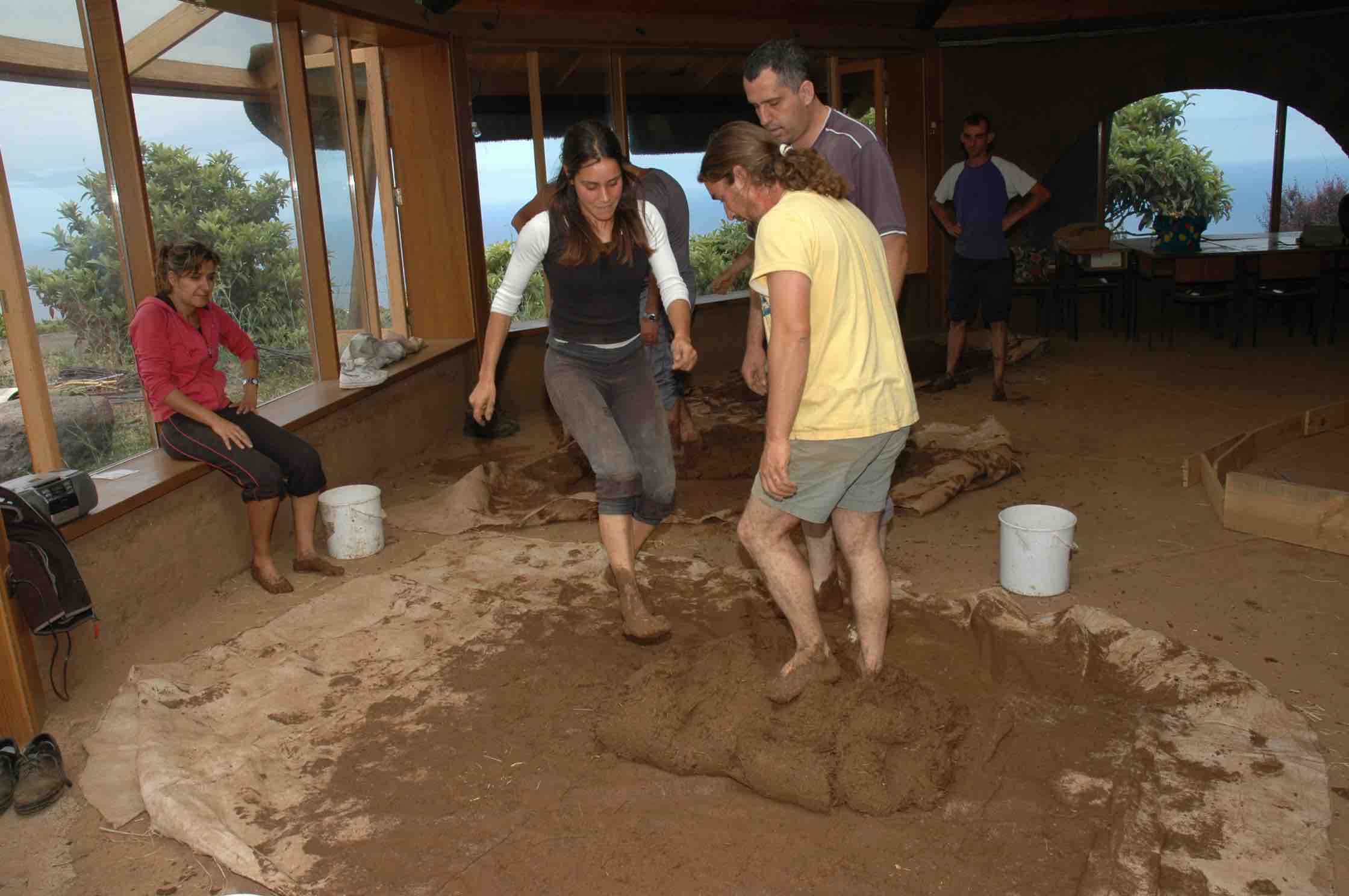
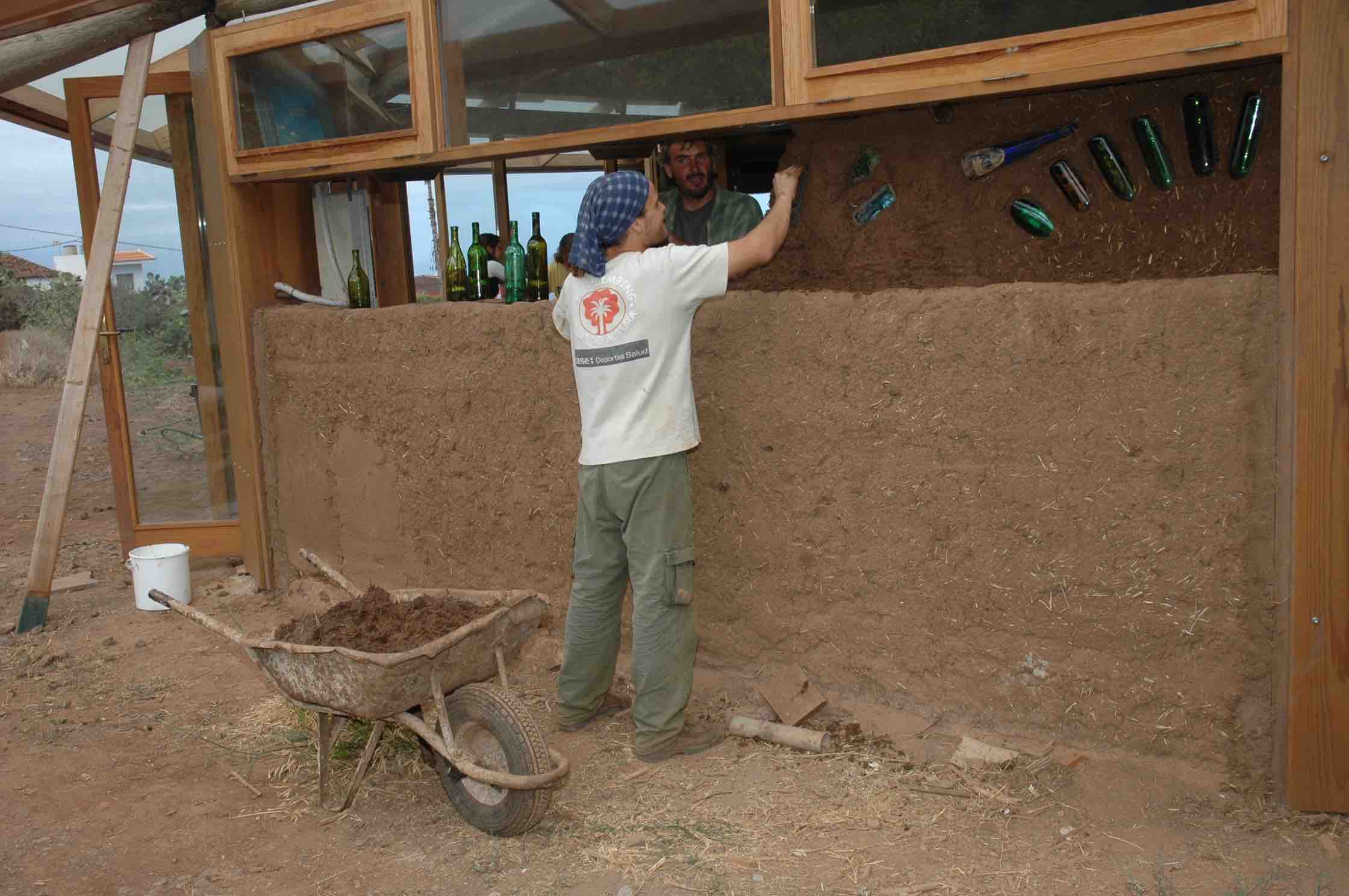
Figure Met.1.- Images of the building process of the bioclimatic classroom in the FEMT
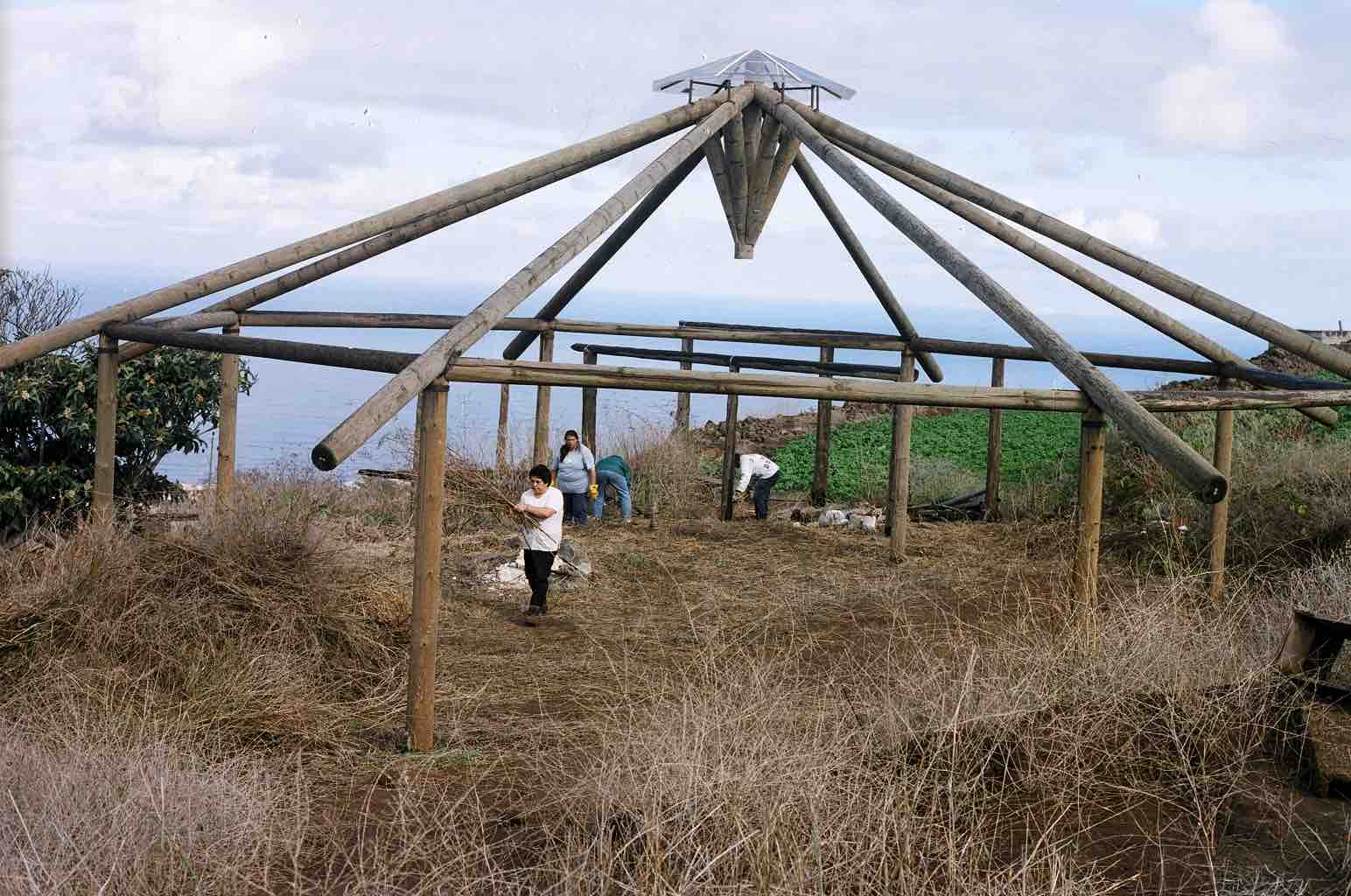

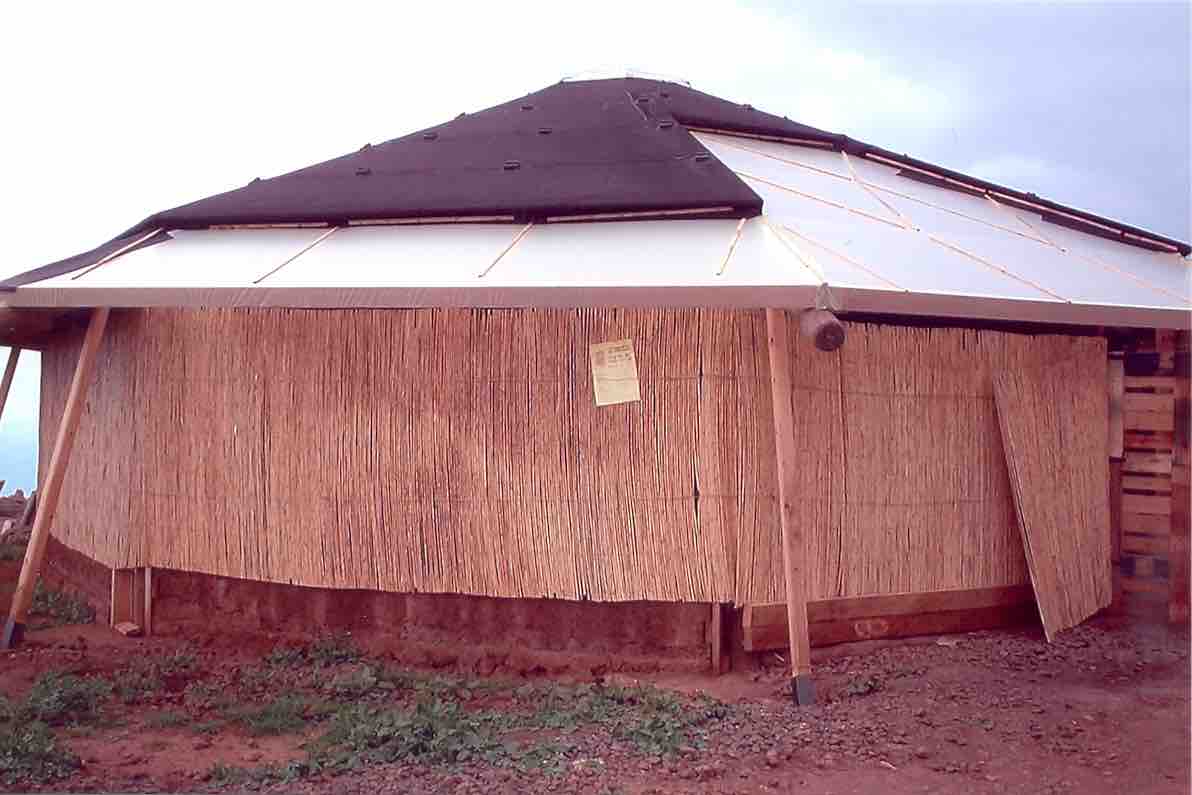
Figure Met.2.- Images of the classroom development
The CEE implementation modus operandi is the “ground connection”: a permanent contact with the soil, animal and plant biodiversity and permacultural design. The use of soil as an educational and therapeutic tool allows developing responsibility, empathy, job training, perseverance, respect, tolerance, teamwork, the work well done, knowledge and respect for the environment… But overall it keeps students focused in the “here and now” as an important step in the development of their mental health.
It has been a co-creation method between the CEE workers and ADP collaborators, students and volunteers that has put its own stamp on every training activity, just like it has put its stamp on the PERMIND project proposal in the very beginning and during the guide preparation, as we will reveal below.
The “ground connection” methodology as a strategy to launch the PERMIND project was suggested and implemented between November 2016 and March 2017 during the co-creation stage. During the proposal development, the ADP asked the project coordinator about prior permaculture knowledge of both the persons responsible of the partner institutions and their instructors that work with persons suffering from mental illness. She answered that there was little knowledge about permaculture in those groups and if the project is approved, project coordinators and trainers would be different persons. The trainers would implement the one-year pilot PERMIND projects, with the aim to experience the 4 different seasons after assisting to an intensive ADP course of Training for Trainers in the Finca El Mato Tinto.
Starting from this very moment, the PERMIND co-creation approach is implemented. Nevertheless, this approach has already been taken into consideration in the PERMIND proposal when talking about the pilot projects to be developed by trainers and students with mental health problems.
The ADP suggested and argued the need of a kick-off project meeting in the FEMT in order to make every PERMIND partner feel and share permaculture and its therapeutic potential.
This meant starting the project with the permacultural approach to “observe first and reflect about what is perceived afterwards”. It is a very profitable exercise consisting in getting to know and feel in situ that creates a link between permaculture and mental health. Plants, animals, landscapes, buildings, technologies and human settlements integrate in harmony and symbiosis to establish a rich diversity. This shows how this integration manages to create a stability and endurance of the natural ecosystems and therefore its higher potential to achieve economic long-term sustainability.
The kick-off “ground connection” was seen as a momentous test for the beginning and the development of the project. It was presented and argued as a challenge that must be addressed in the project proposal.
If the initial “ground connection” in the farm was successful in a first meeting, it would probably encourage partners to share the permaculture experience and its therapeutic potential with their department heads and the future trainers that assist to the intensive course of Training for Trainers (Figure Met.3).
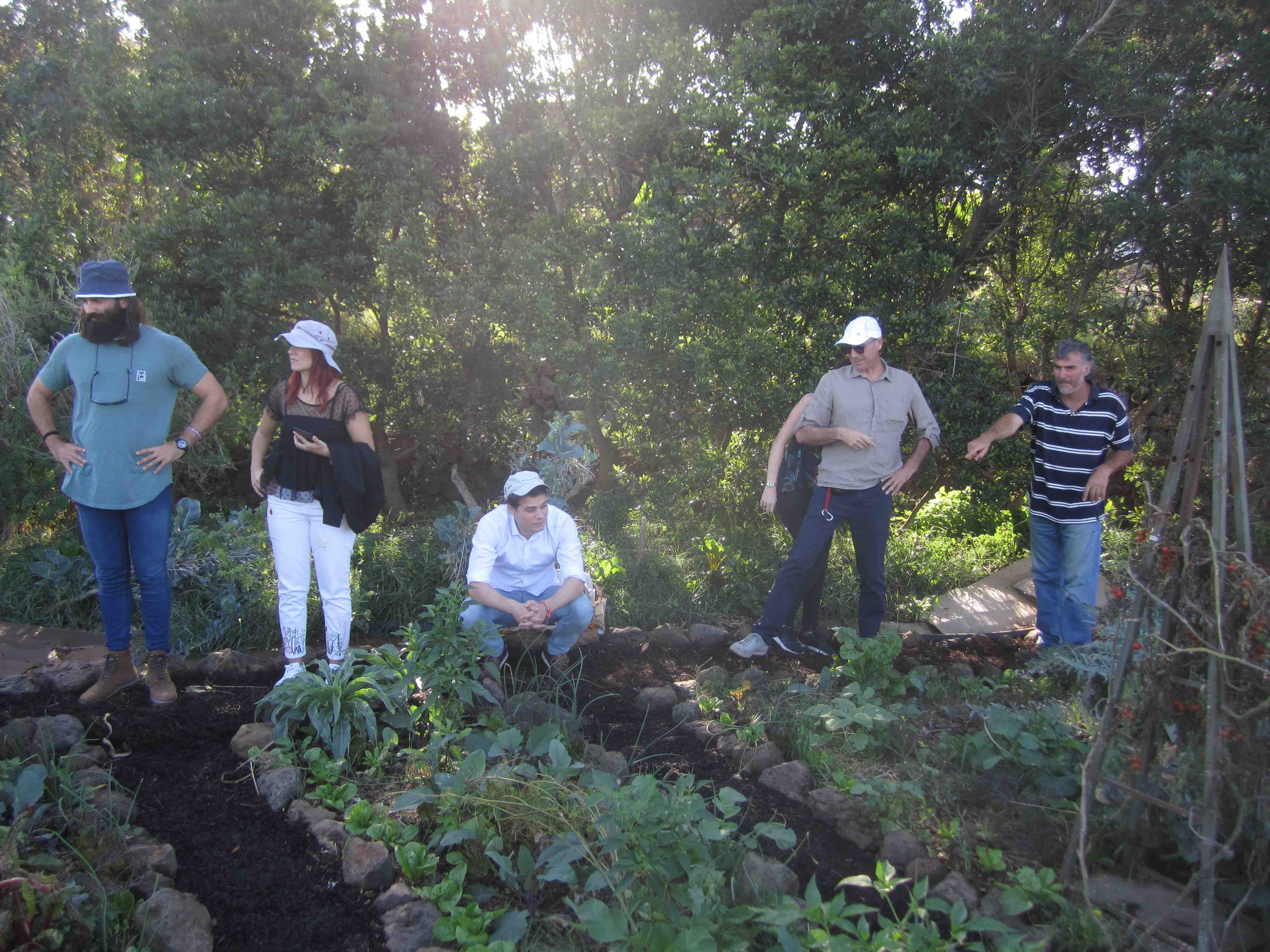
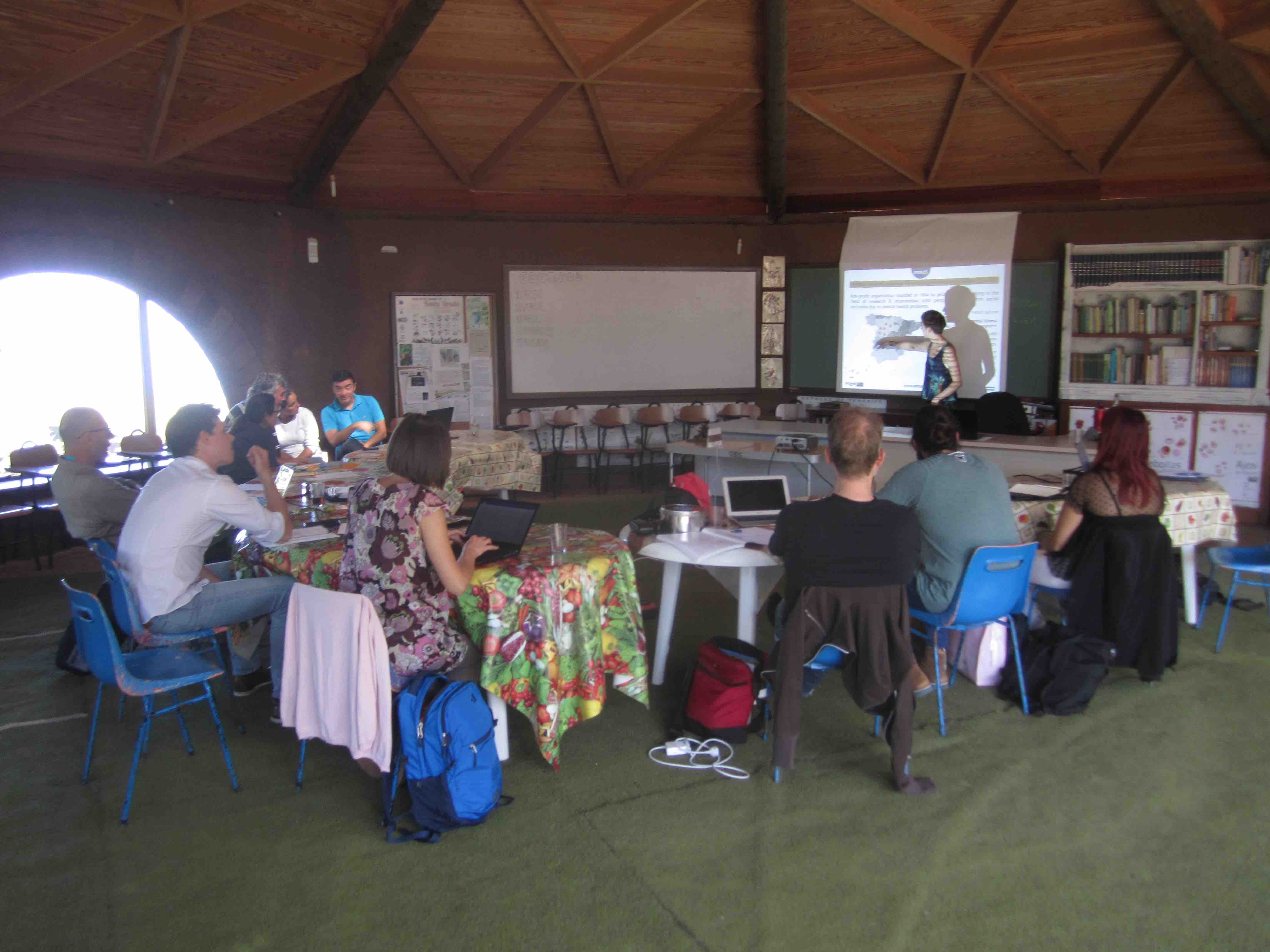
Figure Met.3.- Image of the “ground connection” during the kick-off PERMIND meeting in the FEMT
In PERMIND we talk about pilot projects, monitoring visits to the pilot projects by the ADP, e-learning platforms, apps, but most of all the evaluation of the students of the various pilot projects and of the focus groups (constituted by the relatives of the student, technicians, neighbours, politicians, schools…) to achieve a critical analysis of the projects. All this co-assessment co-creation process would undoubtedly enrich the final PERMIND guide project taking into consideration that at the end of the project the didactic units of the guide will be part of the free access e-learning platform.
The first meeting took place in the farm and, according to the first impressions about the “ground connection” methodology, it’s clear that the main objectives were achieved:
First assessment:
- Very “warm” and nice atmosphere. Also healthy.
- The concept of “equilibrium” was the most important learning during the study visit in the PERMACULTURE gardens.
- The development of a culture (permaculture) that combines and utilizes all sources of energy to create a healthy ecosystem.
- At the moment for me permaculture it’s about building circled relationship between the soil, plants, water, animals and especially people.
- Great, really great hospitality. Very nice organized the whole farm. The works, the connection with the society, the atmosphere between your team.
- The “nature circle” animals -plants-earth is impressive.
- How important is to cultivate soil, sun and water.
- Our eco-system is composed by cycles but for several reasons we usually think about them as independent and not related. Living in urban contexts, it’s really easy to forget this concept because fragmentation is the rule.
- The atmosphere is very nice. The idea of recycling the place shows how is everything part of our life, and can be used for the new beginning.
- The products are from the place. The mode of doing can be replaced in any situation.
- The initiative can be used if you … feel the soil … and if you can understand how the plants are growing.
- Totally different to what we know. Feeling of community and to be part of something, to be part of a natural cycle.
- Interesting, worthy to be known and also to disseminate it to general society
- The philosophy can be used in any situation of the everyday life: management, housing, marriage life, love, partnership, etc.
- Long-term work with relatively immediate results.
- Little investment that eases its sustainability.
- Attractive hook in a community atmosphere and associative movements.
- New professional profiles adapted to the special needs of persons suffering mental health problems.
- Philosophy transfer.
- How therapeutic can be for mentally ill people to cultivate and produce.
- A lot of possibilities of linking persons with mental health problems with this work philosophy.
- What heals the soil can heal the soul of people.
Impressions in terms of questions:
- The connection between Holistic slow approach vs or “just do it attitude”?
- Digitisation and permaculture?
- The connection and the way it’s connected to the high end cuisine restaurants?
- How many people can get food from this system?
- Are we always on time to recover a piece of land?
- Placemaking – the way the method and mindset of PM is connected to urban design. If you find a hole – plant!! [Referring to the act of the hole planting technique of a huge diversity of vegetables in a piece of land full of diversity that seems to be chaotic at first and which vegetable collection becomes an important weekly therapeutic exercise. We talked about this in the “ground connection” and we will keep on talking about it in the Didactic Units III and VI of this guide]
Impressions in terms of doubts:
- About its application in different climatic conditions with strong contrasts.
We have to take into consideration that these impressions were written down at the very beginning of the PERMIND project, two hours after the kick-off meeting at the beginning of the 2-year project.
The summary of what happened during the first meeting reflects very well in the first paragraph of the first project dissemination newsletter: “When we started the PERMIND project in September 2017, none of the partners participating in it had met face-to- face. After the first meeting that we held in Tenerife (Spain) in October, we really felt that we are a family. This is the power of permaculture” (January 2018).
The Training for Trainers course has become the first test to assess the guide quality given the opportunity to assess the differences between what trainers have read in the guide prior to the course and what is taught in the course. At the same time a co-creation exercise takes place during the course, which underlines the guide quality since the most frequent questions serve to create a Frequently Asked Questions section to be added to the final e-learning platform.
The whole image of a “ground connection” with people from various cultural and climatic origins, with shared professional backgrounds and probably different therapeutic cultures, enriches the course itself and the guide and the pilot projects implementation. It certainly favours the creation of a PERMIND exchange network.
Another expression of the co-creation method happens during the PERMIND guide development itself, in the linguistic field. Once written in Spanish by the ADP it was translated to English as the interface language for its later translation to other partner languages (Slovenian, Greek and Swedish).
The ADP requests every partner to not start translating the guide from English until the contrast between what is told in the guide and the information and training transferred during the intensive course has happened. They were asked to physically approximate to the course through the English version guide and to read it as if it were a touristic guide for a place worth visiting. In this case it is about a therapeutic place based on permaculture.
During the intensive course week they met face-to-face with 22 years of permacultural experience of trial-and-error and 16 years of use of permaculture as recovery tool for mental health; an experience in which different methods have been tried and learned from mistake, and which has been summarized and systematized in the PERMIND guide they have read shortly prior to visiting the place. This turns out to be a priceless quality test to assess the guide and to visualize the replicability potential of the pilot projects.
It will also prove to be a co-creation opportunity to work with the trainers as a result of the critical remarks that result of the meeting. The feedbacks from the trainers is revealing to improve the guide quality and to ensure the project evolution. The learning curve derived from the feedbacks is a process to be taken into consideration during the whole implementation of the co-creation pilot project between the instructors and the students. The instructors are the transmitters of the permaculture approach to mental health in their respective institutions – institutions with a long record in the health field.
An important part of the learning process is to reflect on what we learn. Thus, during the training course the trainers take their time at the beginning of the day to analyze the lessons of the previous day. Trainers tested that it was an enriching way to reflect step by step on the learning process and to promote knowledge exchange between participants. It’s recommended to add this follow-up moment at the beginning of each step during the learning process.
The ADP monitoring visits will also be a reciprocity opportunity to get both parts together in the co-creation approach. It will be useful for the ADP to identify the problems that the pilot projects are facing; to solve concerns and doubts shown in the kick-off meeting of the project in October 2017; to take into consideration different climates and cultures; and to enrich along with all of it the national and international coverage of the PERMIND guide.
This joint PERMIND construction by means of evolutionary co-creation method has been very enriching for the development of a guide of this nature. The crowning moment will be the assessment of the students themselves during the guide application in their respective pilot projects. The ADP, as responsible of the guide, will also have the opportunity to share its impressions with those students during the monitoring visits – visits that are important to achieve the PERMIND objectives in the eyes of the project assessors.
This PERMIND guide is not a proper guide about permaculture, it is a guide focused on the healing aspects of permaculture. That is why we begin with “Permaculture as therapy” in the Didactic Unit I and we follow with the remaining units with the design and maintenance of permaculture and the therapy from a simultaneous approach: “Designing the place” (II); “Designing our edible garden” (III); “Edible garden forests” (IV); “Maintaining our edible garden” (V); “From the seed to the harvest” (VI) and “Bioconstruction as a form of therapy” (VII). We finish the guide with an Epilogue by means of a balance of permaculture virtues, highlighting food, habitats and healthy human relationships.
Have a good permacultural and therapeutic trip!
Acronomys Table
ADP: Association for the Development of Permaculture.
CEE: Special Employment Center Finca El Mato Permacultura.
CEIP: Nursery and Primary School.
CIRPAC: Insular Council of Psychosocial Rehabilitation and Community Action.
CIULL: Interdisciplinary Course of University of La Laguna.
CTULL: Transdisciplinary Course of University of La Laguna.
FEMT: El Mato Tinto farm.
IASS: Insular Institute of Social and Socio-Health Care of Tenerife.
ULL: University of La Laguna.



